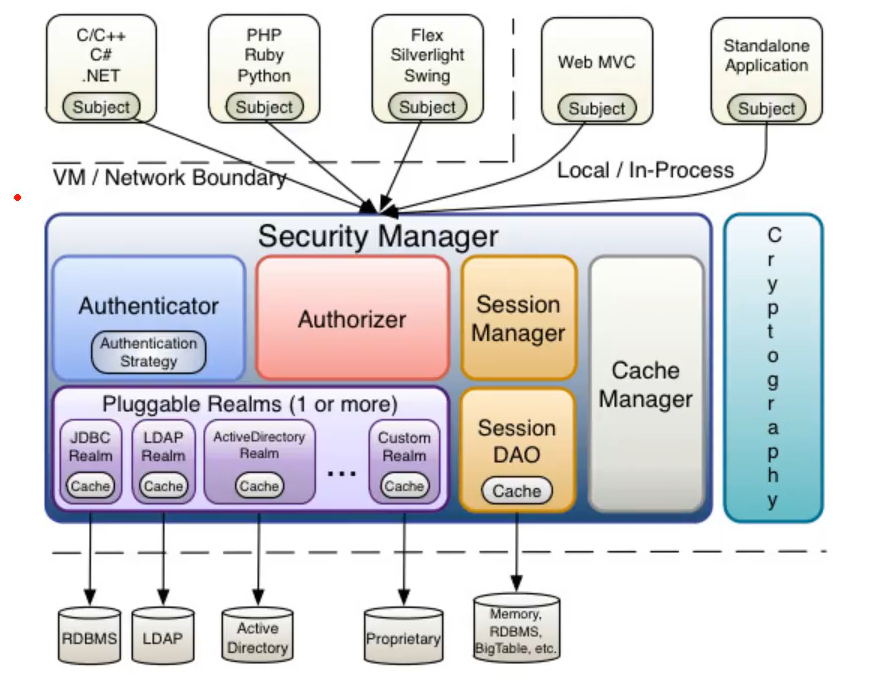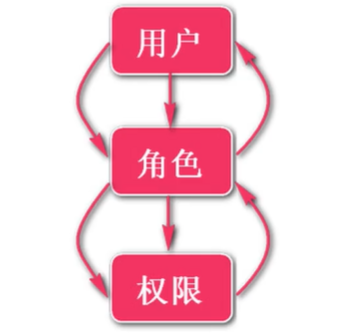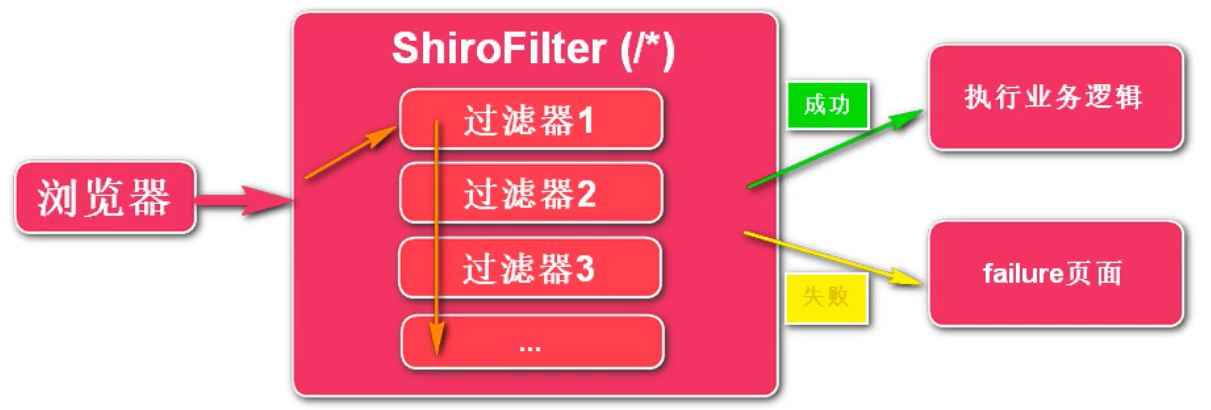前言 参考文章:
https://blog.csdn.net/u012581020/article/details/130627795
一、Shiro框架概述
Shiro 的基本组件包括 Subject、SecurityManager 和 Realms 等。下面我们分别介绍一下这些组件的作用。
Subject
用户可以通过 Subject 登录应用程序,并执行诸如访问资源、修改个人配置等操作。Shiro 提供了简单易用的方法来管理用户的登录和退出行为,以及 Session 管理等。
SecurityManager
SecurityManager 将应用程序中的所有安全操作委托给适当的 Realms 进行处理,并存储和管理有关用户身份、角色和权限等信息。SecurityManager 还可以配置多个 Realms,以便应用程序可以集成不同的认证和授权方案。
Realm
每个 Realm 负责验证用户的身份,并获取用户的权限信息,以便 SecurityManager 可以根据这些信息进行访问控制和授权。Realm 还可以实现缓存机制,提高系统性能。
二、RBAC模型
Role Based Access Control 基于角色的访问控制
模型中的三个主体:用户 角色 权限
每个角色可以有多个权限,每个权限可以分配给多个角色
每个用户可以有多个角色,每个角色可以分配给多个用户
——>两个多对多
权限访问控制,需要做的事是:
身份校验:判断是否为合法用户
权限校验:用户要做某件事或使用某些资源,必须拥有某角色,或必须用有某权限
访问控制管理的过程:
记录用户信息
制定角色
对资源制定权限
将权限分配给不同的角色
将角色分配给具体的用户
三、Shiro入门程序 3.1 pom文件 1 2 3 4 5 6 7 8 9 10 11 12 13 14 15 16 17 18 19 20 21 22 23 24 25 26 27 <dependency > <groupId > org.apache.shiro</groupId > <artifactId > shiro-core</artifactId > <version > 1.7.1</version > </dependency > <dependency > <groupId > org.slf4j</groupId > <artifactId > slf4j-api</artifactId > <version > 2.0.5</version > </dependency > <dependency > <groupId > org.slf4j</groupId > <artifactId > slf4j-log4j12</artifactId > <version > 2.0.5</version > </dependency > <dependency > <groupId > log4j</groupId > <artifactId > log4j</artifactId > <version > 1.2.12</version > </dependency > <dependency > <groupId > commons-logging</groupId > <artifactId > commons-logging</artifactId > <version > 1.2</version > </dependency >
3.2 配置
创建一个shiro.ini文件
1 2 3 4 5 6 7 8 9 10 11 12 13 14 15 16 17 18 19 20 21 22 23 [users] zhangsan =123 ,adminlisi =456 ,manager,sellerwangwu =789 ,clerk[roles] admin =*clear =user:query,user:detial:querymanager =user:*
3.3 代码 1 2 3 4 5 6 7 8 9 10 11 12 13 14 15 16 17 18 19 20 21 22 23 24 25 26 27 28 29 30 31 32 33 34 35 36 37 38 39 40 41 42 43 44 45 46 47 48 49 50 public class TestShiro public static void main (String[] args) IniSecurityManagerFactory factory = new IniSecurityManagerFactory("classpath:shiro.ini" ); SecurityManager securityManager = factory.getInstance(); SecurityUtils.setSecurityManager(securityManager); Subject subject = SecurityUtils.getSubject(); if (!subject.isAuthenticated()) { UsernamePasswordToken zhangsan = new UsernamePasswordToken("zhangsans" , "123" ); try { subject.login(zhangsan); System.out.println("登录成功" ); } catch (UnknownAccountException e) { System.out.println("There is no user with username of " + zhangsan.getPrincipal()); } catch (IncorrectCredentialsException e) { System.out.println("Password for account " + zhangsan.getPrincipal() + "was incorrect!" ); } catch (LockedAccountException e) { System.out.println("The account is locked" ); } catch (AuthenticationException e) { } } if (subject.hasRole("admin" )){ System.out.println("hello,boss" ); } else { System.out.println("hello,user" ); } if (subject.isPermitted("user:update" )){ System.out.println("you can update" ); } else { System.out.println("sorry,you are not allowed to update" ); } subject.logout(); } }
3.4 权限规则
最常用的权限标识:【资源 :操作 】
四、web项目集成
与web项目集成后,shiro的工作模式如下:
如上图所示:
ShiroFilter会拦截浏览器的所有请求,对于请求做访问控制(即判断是否满足身份,角色,权限)
如果没有做身份认证,则强制跳转到登录页面
如果没有充分的角色或权限,则跳转到权限不足的页面
如果校验成功,则顺利执行业务逻辑
4.1 POM 1 2 3 4 5 6 7 8 9 10 11 12 13 14 15 16 17 18 19 20 21 22 23 24 25 26 27 28 29 30 31 32 33 34 35 36 37 38 39 40 41 42 43 44 45 46 47 48 49 50 51 52 53 54 55 56 57 58 59 60 61 62 63 64 65 66 67 68 69 70 71 72 73 74 75 76 77 78 79 80 81 82 83 84 <dependencies > <dependency > <groupId > jakarta.servlet</groupId > <artifactId > jakarta.servlet-api</artifactId > <version > 5.0.0</version > <scope > provided</scope > </dependency > <dependency > <groupId > org.junit.jupiter</groupId > <artifactId > junit-jupiter-api</artifactId > <version > ${junit.version}</version > <scope > test</scope > </dependency > <dependency > <groupId > org.junit.jupiter</groupId > <artifactId > junit-jupiter-engine</artifactId > <version > ${junit.version}</version > <scope > test</scope > </dependency > <dependency > <groupId > commons-logging</groupId > <artifactId > commons-logging</artifactId > <version > 1.1.1</version > </dependency > <dependency > <groupId > org.apache.shiro</groupId > <artifactId > shiro-core</artifactId > <version > 1.10.0</version > </dependency > <dependency > <groupId > org.slf4j</groupId > <artifactId > slf4j-api</artifactId > <version > 2.0.5</version > </dependency > <dependency > <groupId > org.apache.shiro</groupId > <artifactId > shiro-web</artifactId > <version > 1.4.0</version > </dependency > <dependency > <groupId > org.slf4j</groupId > <artifactId > slf4j-log4j12</artifactId > <version > 2.0.5</version > </dependency > <dependency > <groupId > log4j</groupId > <artifactId > log4j</artifactId > <version > 1.2.12</version > </dependency > <dependency > <groupId > javax.servlet.jsp</groupId > <artifactId > jsp-api</artifactId > <version > 2.1</version > <scope > provided</scope > </dependency > <dependency > <groupId > javax.servlet</groupId > <artifactId > jstl</artifactId > <version > 1.2</version > </dependency > <dependency > <groupId > javax.servlet</groupId > <artifactId > javax.servlet-api</artifactId > <version > 3.1.0</version > <scope > provided</scope > </dependency > <dependency > <groupId > org.springframework</groupId > <artifactId > spring-webmvc</artifactId > <version > 4.3.6.RELEASE</version > </dependency > </dependencies >
4.2 代码:Servlet 4.3 配置 4.3.1 web.xml 1 2 3 4 5 6 7 8 9 10 11 12 13 14 15 16 17 18 19 20 <filter > <filter-name > shiroFilter</filter-name > <filter-class > org.apache.shiro.web.servlet.ShiroFilter</filter-class > </filter > <filter-mapping > <filter-name > shiroFilter</filter-name > <url-pattern > /*</url-pattern > </filter-mapping > <listener > <listener-class > org.apache.shiro.web.env.EnvironmentLoaderListener</listener-class > </listener >
4.3. shiro.ini
4.3.3 其他默认过滤器




